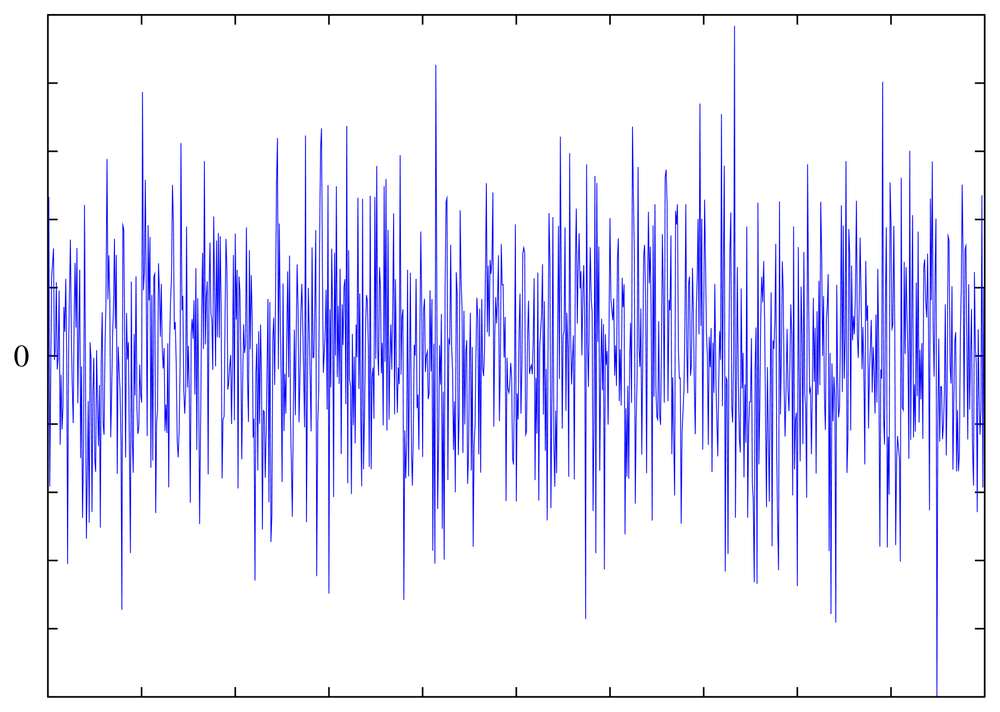Are particles self aware?
Pavitar Devgon discusses Brownian motion

We all think we know what Brownian motion is. It is the way physicists describe the motion of fluids like air and smoke in which the particles moves about, seemingly at random, and diffuse throughout a volume. However, by looking at the microscopic scale where the particles interact, scientists have found a new phenomenon.
Firstly there are two governing forces used to explain Brownian motion, which are ever competing for control. The collisions with surrounding molecules transfer momentum and this is known as ‘thermal noise’. Assumed to be random, it is characterized by a white noise spectrum, which really means that the power (or in this case collisions) contain equal strength within a fixed bandwidth about a centre frequency. In the white noise spectrum (shown right), there are random peaks over all frequencies without clear correlation.
The second force is the viscous friction between the particles and the solvent. In the case of smoke, as the smoke particles diffuse in the air, the higher the viscosity of air the slower the smoke particles diffuse. The effect is one of damping the motion, trying to slow down the particles to rest. An experiment set up by Thomas Franosch, at the Institute for Theoretical Physics at the University of Erlangen-Nuremberg in Germany, and his colleagues shows that it is possible to measure the self-interaction of the particles — how they can interact to change their own motion.
The team trapped a colloid in liquid suspension held in a laser trap to observe the effect of Brownian motion. The sphere of solution was of the order of nanometres in size and when held by the laser, can be modelled as a harmonic oscillator. It was previously considered that the viscous force over-dampens the system and the fluctuating motions are uncorrelated and constant at small frequencies. However, when you bring in the idea of self-interaction, the fluctuations should change and correlate with time.
In order to make the principle of self-interaction apparent, Franosch and his colleagues tune the harmonic oscillator to its relaxation time. In a colloid, the immersed particles will eventually settle and the time it takes to reach this equilibrium position is the relaxation time. As a laser was used to hold the trap, by varying the power of the laser, they could alter the stiffness of the trap and effectively ‘tune’ the relaxation time.
“Evidence has been found to support the theory of self interaction on these scales”
Additionally, using the particle’s diameter and fluid’s viscosity as parameters, the diffusion time (the time to diffuse over the diameter) could be tuned also. Franosch and his colleagues found that the optimum results were obtained from a melamine resin colloid, 3 micrometres in diameter, when immersed in acetone.
The result was a correlation between the fluctuations due to self-interaction and times. It soon became apparent of a hydrodynamic ‘resonance’ occurring close to the relaxation frequency. The power spectral density increased and the ‘white’ noise became ‘coloured’ as the peaks were not constant for all frequencies.
The ramifications of this are remarkable; this is the first time experimental evidence has been found to support the theory of self-interaction on these scales.
It has become clear that particles in solutions are able to affect the result by their presence and hydrodynamic resonance can occur, changing the power spectrum.
One possible move for the future is to create more sensitive equipment, able to work at the micro- and nanometre levels, to measure the shapes, surfaces and distribution of small particles, right down to biological cells.






